Synthesis and Structure of Novel Copper(II) Complexes with N,O- or N,N-Donors as Radical Scavengers and a Functional Model of the Active Sites in Metalloenzymes
Abstract
:1. Introduction
2. Results and Discussion
2.1. Synthetic Considerations in the Self-Assembly of Copper(II) Complexes
2.2. Physicochemical Characterisation of the Complexes
2.2.1. Structural Studies
Molecular Structure of Complex 1
Molecular Structure of Complex 2
Molecular Structure of Complex 3
Molecular Structure of Complex 4
Molecular Structure of Complex 5
2.2.2. Hirshfeld Surface Analysis of the Complexes
2.2.3. FTIR Spectra
2.2.4. UV/Visible Spectra
2.2.5. Electron Paramagnetic Resonance Spectra and Magnetic Moment Measurement
2.3. Biological Activity Research
2.3.1. Free Radical Scavenging Ability of Copper(II) Complexes with Heteroaromatic Alcohols
2.3.2. Activity Levels of Blood Antioxidants after Treatment of Oncology Patients and in the Control Group (Healthy Patients)
2.3.3. Evaluation of the Effect of a Selected Copper(II) Complex on the Level of Antioxidant Activity in a Group of Patients after Chemo- and Radiotherapy
3. Experimental
3.1. Materials and Instrumentation
3.2. Preparation of Complexes
3.2.1. Synthesis of [Cu(2-(HOCH2)py)3](ClO4)2 (1)
3.2.2. Synthesis of [Cu(2-(HOCH2)py)2(H2O)2]SiF6 (2)
3.2.3. Synthesis of [Cu2(2-(HOCH2CH2)py)2(2-(OCH2CH2)py)2](ClO4)2 (3)
3.2.4. Synthesis of [Cu(pyBIm)3](BF4)2·1.5H2O (4)
3.2.5. Synthesis of [Cu(py2C(OH)2)2](ClO4)2 (5)
3.3. Crystallographic Data Collection and Structure Refinement
3.4. Determination of Antioxidant Activity by the ABTS Test
3.5. Cell Culture and Viability Assays
3.6. The Antioxidant Status of the Plasma in Oncology Patients
3.6.1. Participants, Blood Collection and Processing
3.6.2. The Activity of Antioxidant Enzymes
3.6.3. Statistical Analysis
4. Conclusions
Supplementary Materials
Author Contributions
Funding
Institutional Review Board Statement
Informed Consent Statement
Acknowledgments
Conflicts of Interest
References
- Masternak, J.; Gilewska, A.; Barszcz, B.; Łakomska, I.; Kazimierczuk, K.; Sitkowski, J.; Wietrzyk, J.; Kamecka, A.; Milczarek, M. Ruthenium(II) and iridium(III) complexes as tested materials for new anticancer agents. Materials 2020, 13, 3491. [Google Scholar] [CrossRef] [PubMed]
- Gilewska, A.; Barszcz, B.; Masternak, J.; Kazimierczuk, K.; Sitkowski, J.; Wietrzyk, J.; Turlej, E. Similarities and differences in d6 low-spin ruthenium, rhodium and iridium half-sandwich complexes: Synthesis, structure, cytotoxicity and interaction with biological targets. J. Biol. Inorg. Chem. 2019, 24, 591–606. [Google Scholar] [CrossRef] [PubMed] [Green Version]
- Kowalik, M.; Masternak, J.; Łakomska, I.; Kazimierczuk, K.; Zawilak-Pawlik, A.; Szczepanowski, P.; Khavryuchenko, O.V.; Barszcz, B. Structural insights into new Bi (III) coordination polymers with pyridine-2,3-dicarboxylic acid: Photoluminescence properties and anti-helicobacter pylori activity. Int. J. Mol. Sci. 2020, 21, 8696. [Google Scholar] [CrossRef]
- Ray, P.D.; Huang, B.W.; Tsuji, Y. Reactive oxygen species (ROS) homeostasis and redox regulation in cellular signaling. Cell. Signal. 2012, 24, 981–990. [Google Scholar] [CrossRef] [PubMed] [Green Version]
- Collin, F. Chemical basis of reactive oxygen species reactivity and involvement in neurodegenerative diseases. Int. J. Mol. Sci. 2019, 20, 2407. [Google Scholar] [CrossRef] [PubMed] [Green Version]
- Andersen, J.K. Oxidative stress in neurodegeneration: Cause or consequence? Nat. Rev. Neurosci. 2004, 10, S18. [Google Scholar] [CrossRef] [PubMed]
- Benedetto, A.; Au, C.; Aschner, M. Manganese-induced dopaminergic neurodegeneration: Insights into mechanisms and genetics shared with parkinson’s disease. Chem. Rev. 2009, 109, 4862–4884. [Google Scholar] [CrossRef] [PubMed]
- Shukla, V.; Mishra, S.K.; Pant, H.C. Oxidative stress in neurodegeneration. Adv. Pharmacol. Sci. 2011, 2011, 572634. [Google Scholar] [CrossRef] [PubMed] [Green Version]
- Trachootham, D.; Alexandre, J.; Huang, P. Targeting cancer cells by ROS-mediated mechanisms: A radical therapeutic approach? Nat. Rev. Drug Discov. 2009, 8, 579–591. [Google Scholar] [CrossRef]
- Ghaffari, S. Oxidative stress in the regulation of normal and neoplastic hematopoiesis. Antioxid. Redox Signal. 2008, 10, 1923–1940. [Google Scholar] [CrossRef] [Green Version]
- Zhang, J.; Lei, W.; Chen, X.; Wang, S.; Qian, W. Oxidative stress response induced by chemotherapy in leukemia treatment (Review). Mol. Clin. Oncol. 2018, 8, 391–399. [Google Scholar] [CrossRef] [Green Version]
- Ighodaro, O.M.; Akinloye, O.A. First line defence antioxidants-superoxide dismutase (SOD), catalase (CAT) and glutathione peroxidase (GPX): Their fundamental role in the entire antioxidant defence grid. Alex. J. Med. 2018, 54, 287–293. [Google Scholar] [CrossRef] [Green Version]
- Zienkiewicz, M.; Jabłońska-Wawrzycka, A.; Szlachetko, J.; Kayser, Y.; Stadnicka, K.; Sawka-Dobrowolska, W.; Jezierska, J.; Barszcz, B.; Sá, J. Effective catalytic disproportionation of aqueous H2O2 with di- and mono-nuclear manganese(II) complexes containing pyridine alcohol ligands. Dalt. Trans. 2014, 43, 8599–8608. [Google Scholar] [CrossRef]
- Zienkiewicz, M.; Szlachetko, J.; Lothschütz, C.; Hodorowicz, M.; Jabłońska-Wawrzycka, A.; Sá, J.; Barszcz, B. A novel single-site manganese(II) complex of a pyridine derivative as a catalase mimetic for disproportionation of H2O2 in water. Dalt. Trans. 2013, 42, 7761–7767. [Google Scholar] [CrossRef]
- Papaefstathiou, G.S.; Perlepes, S.P. Families of polynuclear manganese, cobalt, nickel and copper complexes stabilized by various forms of di-2-pyridyl ketone. Comments Inorg. Chem. 2002, 23, 249–274. [Google Scholar] [CrossRef]
- Jin, L.; Uemura, K.; Ebihara, M. Assembled structures of tetrakis(biimidazole)dirhodium complexes hydrogen-bonded with common inorganic anions. Acta Crystallogr. Sect. B Struct. Sci. Cryst. Eng. Mater. 2014, 70, 1006–1019. [Google Scholar]
- Hathaway, B.; Duggan, M.; Murphy, A.; Mullane, J.; Power, C.; Walsh, A.; Walsh, B. The stereochemistry and electronic properties of fluxional six-coordinate copper (II) complexes. Coord. Chem. Rev. 1981, 36, 267–324. [Google Scholar] [CrossRef]
- Stachová, P.; Melník, M.; Korabik, M.; Mrozinski, J.; Koman, M.; Glowiak, T.; Valigura, D. Synthesis, spectral and magnetical characterization of monomeric [Cu(2-NO2bz)2(nia)2(H2O)2] and structural analysis of similar [Cu(RCOO)2(L-N)2(H2O)2] complexes. Inorg. Chim. Acta 2007, 360, 1517–1522. [Google Scholar] [CrossRef]
- Wojciechowska, A.; Pietraszko, A.; Bronowska, W.; Staszak, Z.; Jezierska, J.; Cieślak-Golonka, M. Geometric distortions of octahedral cations and tetrahedral anions in disordered [Cu(bpy)3] CrO4·7.5H2O crystal—A comparative study. Polyhedron 2010, 29, 2574–2581. [Google Scholar] [CrossRef]
- Hoang, N.N.; Valach, F.; Dunaj-Jurčo, M.; Melník, M. Structure of bis(salicylato)bis(2-pyridylmethanol) copper (II). Acta Crystallogr. Sect. C Cryst. Struct. Commun. 1992, 48, 443–445. [Google Scholar] [CrossRef]
- Antonioli, B.; Bray, D.J.; Clegg, J.K.; Jolliffe, K.A.; Gloe, K.; Gloe, K.; Lindoy, L.F. Proton and anion control of framework complexity in copper (II) complex structures derived from 2-(hydroxymethyl)pyridine. Polyhedron 2007, 26, 673–678. [Google Scholar] [CrossRef]
- Moncol, J.; Kalinakova, B.; Svorec, J.; Kleinova, M.; Koman, M.; Hudecova, D.; Melnik, M.; Mazur, M.; Valko, M. Spectral properties and bio-activity of copper (II) clofibriates, part III: Crystal structure of Cu(clofibriate)2(2-pyridylmethanol)2, Cu(clofibriate)2(4-pyridylmethanol)2(H2O) dihydrate, and Cu2(clofibriate)4(N,N-diethylnicotinamide)2. Inorg. Chim. Acta 2004, 357, 3211–3222. [Google Scholar] [CrossRef]
- Pucekova-Repicka, Z.; Moncol, J.; Valigura, D.; Lis, T.; Korabik, M.; Melník, M.; Mroziński, J.; Mazúr, M. Synthesis, structure, spectral and magnetic properties of 4-methoxy- and 3-methylsalicylatocopper(II) complexes with 2-pyridylmethanol. J. Coord. Chem. 2007, 60, 2449–2460. [Google Scholar] [CrossRef]
- Dewan, J.C.; Thompson, L.K. Copper tetrafluoroborate complexes of the potentially binucleating ligand 1,4-di(2′-pyridyl)aminophthalazine. Mononuclear and polynuclear derivatives. Can. J. Chem. 1982, 60, 121–132. [Google Scholar] [CrossRef]
- Addison, A.W.; Rao, T.N.; Reedijk, J.; van Rijn, J.; Verschoor, G.C. Synthesis, structure, and spectroscopic properties of copper(II) compounds containing nitrogen-sulphur donor ligands. J. Chem. Soc. Dalt. Trans 1984, 7, 1349–1356. [Google Scholar] [CrossRef]
- Xiong, Y.A.H. A copper (II) complex with 2-(2′-pyridyl)benzimidazole and L-arginine: Synthesis, structure, antibacterial activities, and DNA interaction. J. Cord. Chem. 2013, 66, 2152–2165. [Google Scholar]
- Altaf, M.; Stoeckli-Evans, H. Nickel(II) and copper(II) complexes of 2-(2-pyridyl)benzimidazole: Synthesis and structural characterization. Transit. Met. Chem. 2009, 34, 613–620. [Google Scholar] [CrossRef]
- Parker, O.J.; Aubol, S.L.; Breneman, G.L. Crystal structure of a copper stabilized hydrate of di-2-pyridyl ketone. Polyhedron 2000, 19, 623–626. [Google Scholar] [CrossRef]
- Serna, Z.; Barandika, M.G.; Cortés, R.; Urtiaga, M.K.; Arriortua, M.I. Crystal structure and ESR spectra of two M(II)-dpk-NCS coordination compounds (M = Mn, Cu and dpk = di-2-pyridilketone). Polyhedron 1998, 18, 249–255. [Google Scholar] [CrossRef]
- Zeller, M.; Westcott, B.L.; Kopp-Vaughn, K.M.; Hunter, A.D. Catena-Poly[[μ-bromido-(μ-hydroxydi-2-pyridylmethanolato- κ4 N,O:O,N′)dicopper(II)(Cu—Cu)]-di-μ-bromido]. Acta Crystallogr. Sect. E Struct. Rep. Online 2008, 64, 67–72. [Google Scholar] [CrossRef] [Green Version]
- Yang, G.; Tong, M.L.; Chen, X.M.; Ng, S.W. Bis(di-2-pyridylmethanediol-N,O,N′)-copper(II) diperchlorate. Acta Crystallogr. Sect. C Cryst. Struct. Commun. 1998, 54, 732–734. [Google Scholar] [CrossRef]
- Reinoso, S.; Vitoria, P.; Felices, L.S.; Lezama, L.; Gutiérrez-Zorrilla, J.M. Bis(di-2-pyridylmethanediol-κ3N,O,N′)-copper(II) diacetate tetrahydrate. Acta Crystallogr. Sect. E Struct. Rep. Online 2003, 59, 548–550. [Google Scholar] [CrossRef]
- Zhao, J.; Li, D.S.; Dong, W.W.; Wang, D.J.; Guo, L. Bis(di-2-pyridylmethane-diol-κ3N,O,N′)copper(II) DL-tartrate. Acta Crystallogr. Sect. E Struct. Rep. Online 2008, 64. [Google Scholar] [CrossRef] [Green Version]
- Breeze, S.R.; Wang, S.; Greedan, J.E.; Raju, N.P.; Canada, L.S. Copper and bismuth complexes containing dipyridyl gem-diolato ligands: BiIII2[(2-Py)2CO(OH)]2(O2CCF3)4(THF)2, CuII[(2-Py)2CO(OH)]2(HO2CCH3)2, and CuII4[(2-Py)2CO(OH)]2(O2CCH3)6(H2O)2, a ferromagnetically coupled tetranuclear copper (II) chain. Inorg. Chem. 1996, 2, 6944–6951. [Google Scholar] [CrossRef]
- Brown, K.L.; Crundwell, G.; Westcott, B.L. Bis(di-2-pyridylmethanediol-κ3N,O,N′)copper(II) bis(tetrafluoridoborate) dihydrate. Acta Crystallogr. Sect. E Struct. Rep. Online 2009, 65. [Google Scholar] [CrossRef] [Green Version]
- Latham, K.; White, K.F.; Szpakolski, K.B.; Rix, C.J.; White, J.M. Synthesis, crystal structure and luminescent behaviour of coordination complexes of copper with bi- and tridentate amines and phosphonic acids. Inorg. Chim. Acta 2009, 362, 1872–1886. [Google Scholar] [CrossRef]
- Li, C.J.; Li, W.; Tong, M.L.; Ng, S.W. A C-centered monoclinic modification of bis(di-2-pyridylmethanediol-κ3N,O,N′)-copper(II) diacetate tetrahydrate. Acta Crystallogr. Sect. E Struct. Rep. Online 2005, 61, 232–234. [Google Scholar] [CrossRef]
- Westcott, B.L.; Kopp-Vaughn, K.M.; Daniels, L.M.; Zeller, M. Di-μ-bromido-bis-[bromido(di-2-pyridylmethanediol-κ N,N′)copper(II)] dihydrate. Acta Crystallogr. Sect. E Struct. Rep. Online 2008, 64. [Google Scholar] [CrossRef] [Green Version]
- Nakamoto, K. Infrared and Raman Spectra of Inorganic and Coordination Compounds, Part B., 6th ed.; Wiley: Hoboken, NJ, USA, 2009. [Google Scholar]
- Driessen, R.A.J.; Hulsbergen, F.B.; Vermin, W.J.; Reedijk, J. Synthesis, Structure, spectroscopy, and magnetism of transition-metal compounds with bridging hexafluorosilicate groups. Crystal and molecular structure of catena-(μ-hexafluorosilicato)tetrakis (N-vinylimidazole)cobalt(II). Inorg. Chem. 1982, 21, 3594–3597. [Google Scholar] [CrossRef]
- Lever, A.B.P. Inorganic Electronic Spectroscopy; Elsevier: New York, NY, USA, 1984. [Google Scholar]
- Massoud, S.S.; Louka, F.R.; Al-Hasan, M.A.; Vicente, R.; Mautner, F.A. Magneto-structural properties of carbonato-bridged copper (II) complexes: Fixation of atmospheric CO2. New J. Chem. 2015, 39, 5944–5952. [Google Scholar] [CrossRef]
- Hasanvand, F.; Ahmadi, R.A.; Amani, S. Synthesis, Spectroscopy and magnetic characterization of five dinuclear copper (II) complexes with 2, 3 or 4-pyridinemethanol as the ligand. J. Sci. Islam. Repub. Iran 2012, 23, 37–43. [Google Scholar]
- Driessen, W.L.; Maase, B.; Reedijk, J.; Kooijman, H.; Lakin, M.T.; Spek, A.L. A dinuclear copper (II) and a mononuclear cobalt (II) compound of the didentate N,O-donor ligand 1-(2-hydroxyethyl)-3,5-dimethylpyrazole. Inorg. Chim. Acta 2000, 300–302, 1099–1103. [Google Scholar] [CrossRef]
- Driessen, W.L.; Gorter, S.; Haanstra, W.G.; Laarhoven, L.J.J.; Reedijk, J.; Goubitz, K.; Seljée, F.R. Coordination properties of the didentate N,O ligand 1-(2-hydroxyethyl)-3,5-dimethylpyrazole (hl). Crystal structure of [Cu(HL)2(NO3)2] and [Cu(L)Br]2. Recl. des Trav. Chim. des Pays Bas 1993, 112, 309–313. [Google Scholar] [CrossRef]
- Hodgson, D.J. Magnetic interaction between metals separated by single atom bridges. J. Mol. Catal. 1984, 23, 219–233. [Google Scholar] [CrossRef]
- Repich, H.H.; Orysyk, S.I.; Orysyk, V.V.; Zborovskii, Y.L.; Melnyk, A.K.; Trachevskyi, V.V.; Pekhnyo, V.I.; Vovk, M.V. Influence of synthesis conditions on complexation of Cu(II) with O,N,O tridentate hydrazone ligand. X-ray diffraction and spectroscopic investigations. J. Mol. Struct. 2017, 1146, 222–232. [Google Scholar] [CrossRef]
- Yeh, C.C.; Hou, M.F.; Tsai, S.M.; Lin, S.K.; Hsiao, J.K.; Huang, J.C.; Wang, L.H.; Wu, S.H.; Hou, L.A.; Ma, H.; et al. Superoxide anion radical, lipid peroxides and antioxidant status in the blood of patients with breast cancer. Clin. Chim. Acta 2005, 361, 104–111. [Google Scholar] [CrossRef]
- Kasapović, J.; Pejić, S.; Stojiljković, V.; Todorović, A.; Radošević-Jelić, L.; Saiĉić, Z.S.; Pajović, S.B. Antioxidant status and lipid peroxidation in the blood of breast cancer patients of different ages after chemotherapy with 5-fluorouracil, doxorubicin and cyclophosphamide. Clin. Biochem. 2010, 43, 1287–1293. [Google Scholar] [CrossRef]
- Kasapović, J.; Pejić, S.; Todorović, A.; Stojiljković, V.; Radošević-Jelić, L.; Pajović, S.B. Antioxidant staus in breast cancer patients of different ages after radiotherapy. Arch. Biol. Sci. 2009, 61, 23–28. [Google Scholar] [CrossRef]
- Arslantas, A. Development of functional models for a SOD. Met. Based. Drugs 2002, 9, 9–18. [Google Scholar] [CrossRef] [Green Version]
- Nuran Ercal, B.S.P.; Hande Gurer-Orhan, B.S.P.; Nukhet Aykin-Burns, B.S.P. Toxic Metals and Oxidative Stress Part I: Mechanisms Involved in Metal induced Oxidative Damage. Curr. Top. Med. Chem. 2005, 1, 529–539. [Google Scholar] [CrossRef]
- Patel, R.N.; Shukla, K.K.; Singh, A.; Choudhary, M.; Chauhan, U.K.; Dwivedi, S. Copper (II) complexes as superoxide dismutase mimics: Synthesis, characterization, crystal structure and bioactivity of copper (II) complexes. Inorg. Chim. Acta 2009, 362, 4891–4898. [Google Scholar] [CrossRef]
- Day, B.J. Catalase and glutathione peroxidase mimics. Biochem. Pharmacol. 2009, 77, 285–296. [Google Scholar] [CrossRef] [Green Version]
- Day, B.J. Catalytic antioxidants: A radical approach to new therapeutics. Drug Discov. Today 2004, 9, 557–566. [Google Scholar] [CrossRef]
- Batinić-Haberle, I.; Rebouças, J.S.; Spasojević, I. Superoxide dismutase mimics: Chemistry, pharmacology, and therapeutic potential. Antioxid. Redox Signal 2010, 13, 877–918. [Google Scholar] [CrossRef] [Green Version]
- Ożarowski, A. Spin Software; National High Magnetic Field Laboratory, Florida State University: Tallahassee, FL, USA, 2015. [Google Scholar]
- Nonius COLLECT; Nonius BV: Delft, The Netherlands, 2000.
- Otwinowski, Z.; Minor, W. Processing of X-ray diffraction data collected in oscillation mode. Methods Enzymol. 1997, 276, 307–326. [Google Scholar]
- Altomare, A.; Burla, M.C.; Cascarano, G.; Giacovazzo, C.; Guagliardi, A.; Moliterni, A.G.G.; Polidori, G. Early finding of preferred orientation: Applications to direct methods. J. Appl. Crystallogr. 1996, 29, 341–345. [Google Scholar] [CrossRef]
- Scheldrick, G.M. SHELXL-97, Program for Crystal Structure Refinement; University of Göttingen: Göttingen, Germany, 1997. [Google Scholar]
- STOE & Cie GmbH. X-Area 1.75, Software Package for Collecting Single-Crystal Data on STOE Area-Detector Diffractometers, for Image Processing, Scaling Reflection Intensities and for Outlier Rejection; STOE & Cie GmbH: Darmstad, Germany, 2015. [Google Scholar]
- Sheldrick, G.M. A short history of SHELX. Acta Crystallogr. Sect. A Found. Crystallogr. 2008, 64, 112–122. [Google Scholar] [CrossRef] [Green Version]
- Sheldrick, G.M. SHELXL-2014; Univeristy of Götigen; Bruker AXS: Karlsruhe, Germany, 2014. [Google Scholar]
- Dolomanov, O.V.; Bourhis, L.J.; Gildea, R.J.; Howard, J.A.K.; Puschmann, H. OLEX2: A complete structure solution, refinement and analysis program. J. Appl. Crystallogr. 2009, 42, 339–341. [Google Scholar] [CrossRef]
- Farrugia, L.J. WinGX and ORTEP for Windows: An update. J. Appl. Crystallogr. 2012, 45, 849–854. [Google Scholar] [CrossRef]
- Brandenburg, K.; Putz, H. Diamond–Crystal and Molecular Structure VisualizationCrystal Impact; GbR: Bonn, Germany, 2000; Version 3.1 f. [Google Scholar]
- Forni, L.G.; Mora-Arellano, V.; Packer, J.E.; Willson, R.L. Nitrogen dioxide and related free radicals: Electron-transfer reactions with organic compounds in solutions containing nitrite or nitrate. J. Chem. Soc. Perkin Trans. II 1986, 1, 1–6. [Google Scholar] [CrossRef]
- Rogala, P.; Jabłońska-Wawrzycka, A.; Kazimierczuk, K.; Borek, A.; Błażejczyk, A.; Wietrzyk, J.; Barszcz, B. Synthesis, crystal structure and cytotoxic activity of ruthenium (II) piano-stool complex with N.,N-chelating ligand. J. Mol. Struct. 2016, 1126, 74–82. [Google Scholar] [CrossRef]
- Miller, N.J.; Rice-Evans, C.; Davies, M.J.; Gopinathan, V.; Milner, A. A novel method for measuring antioxidant capacity and its application to monitoring the antioxidant status in premature neonates. Clin. Sci. 1993, 84, 407–412. [Google Scholar] [CrossRef] [Green Version]
- McCord, J.M.; Fridivich, I. Superoxide dismutase An enzymic function for erythrocuprein (Hemocuprein). J. Biol. Chem. 1969, 244, 6049–6055. [Google Scholar] [CrossRef]
- Wheeler, C.R.; Salzman, J.A.; Elsayed, N.M.; Omaye, S.T.; Korte, D.W. Automated assays for superoxide dismutase, catalase, glutathione peroxidase, and glutathione reductase activity. Anal. Biochem. 1990, 184, 193–199. [Google Scholar] [CrossRef]
- Paglia, D.E.; Valentine, W.N. Studies on the quantitative and qualitative characterization of erythrocyte glutathione peroxidase. J. Lab. Clin. Med. 1967, 70, 158–169. [Google Scholar]
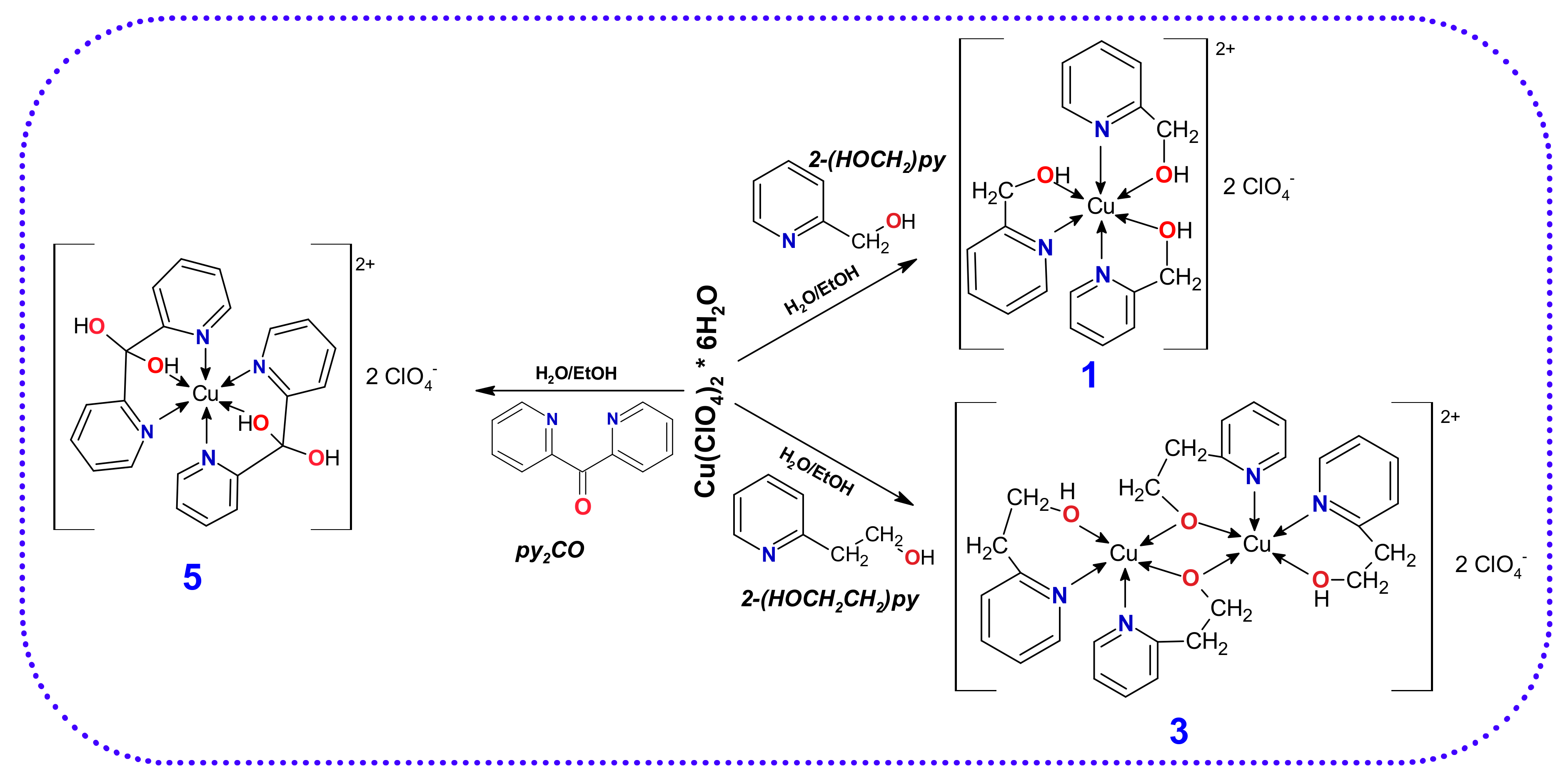

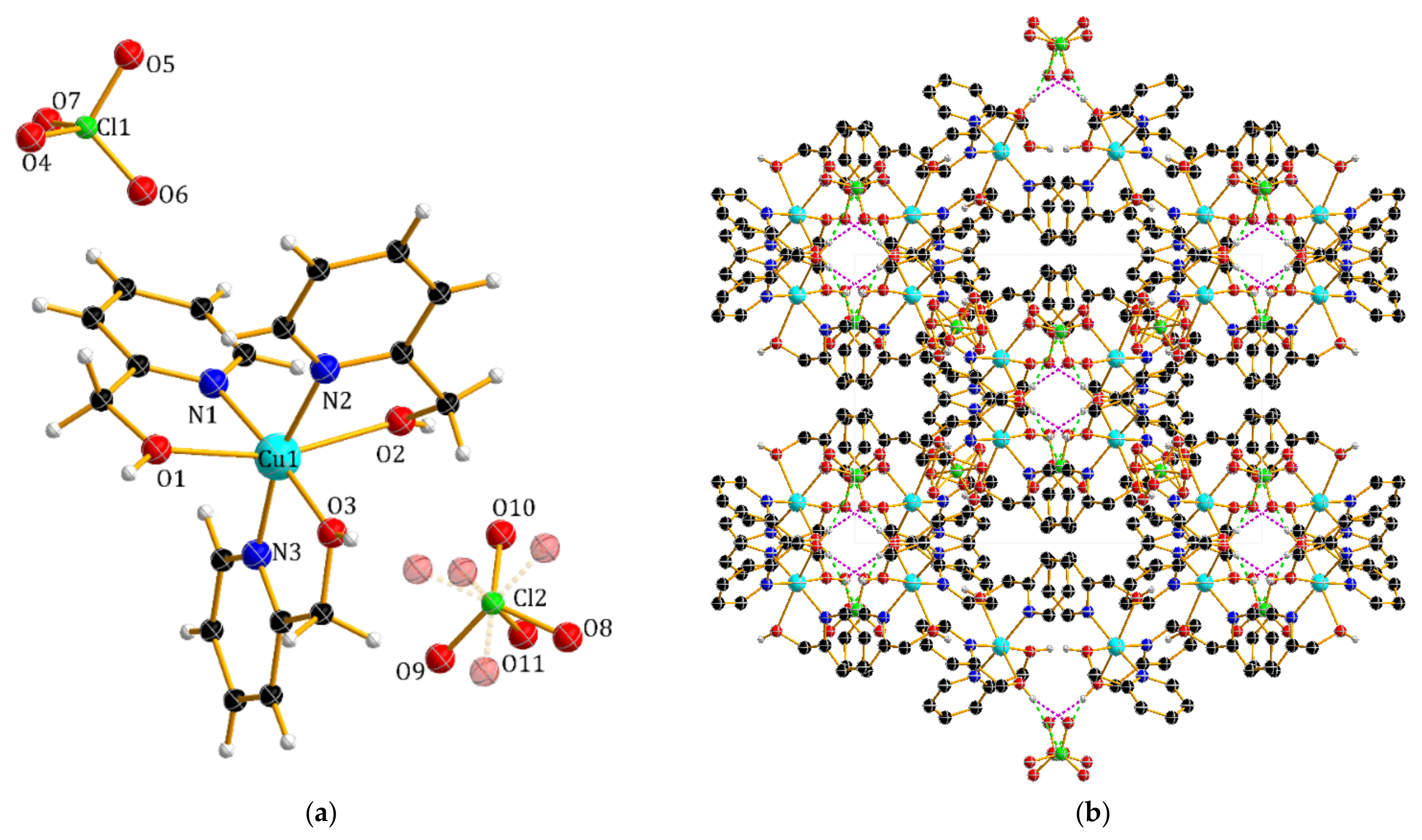
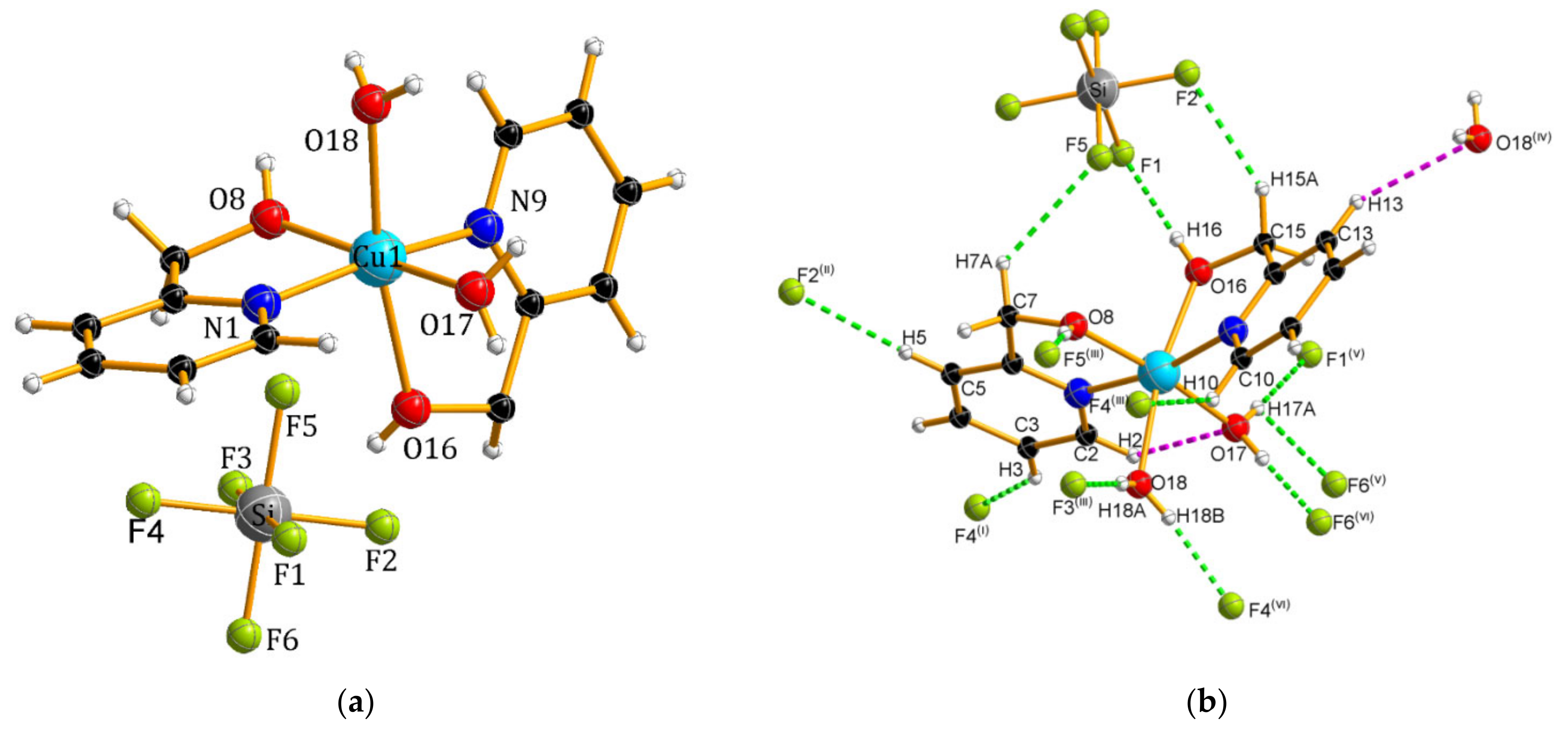
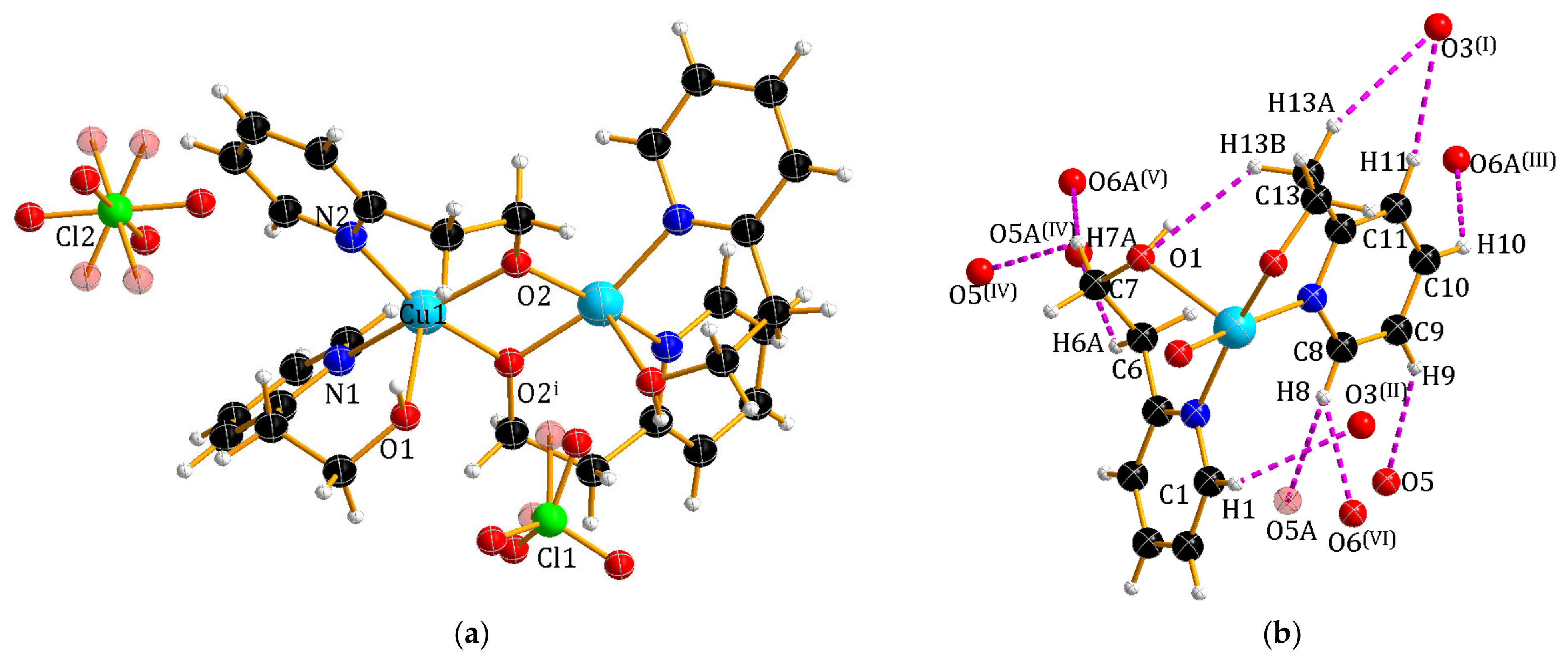
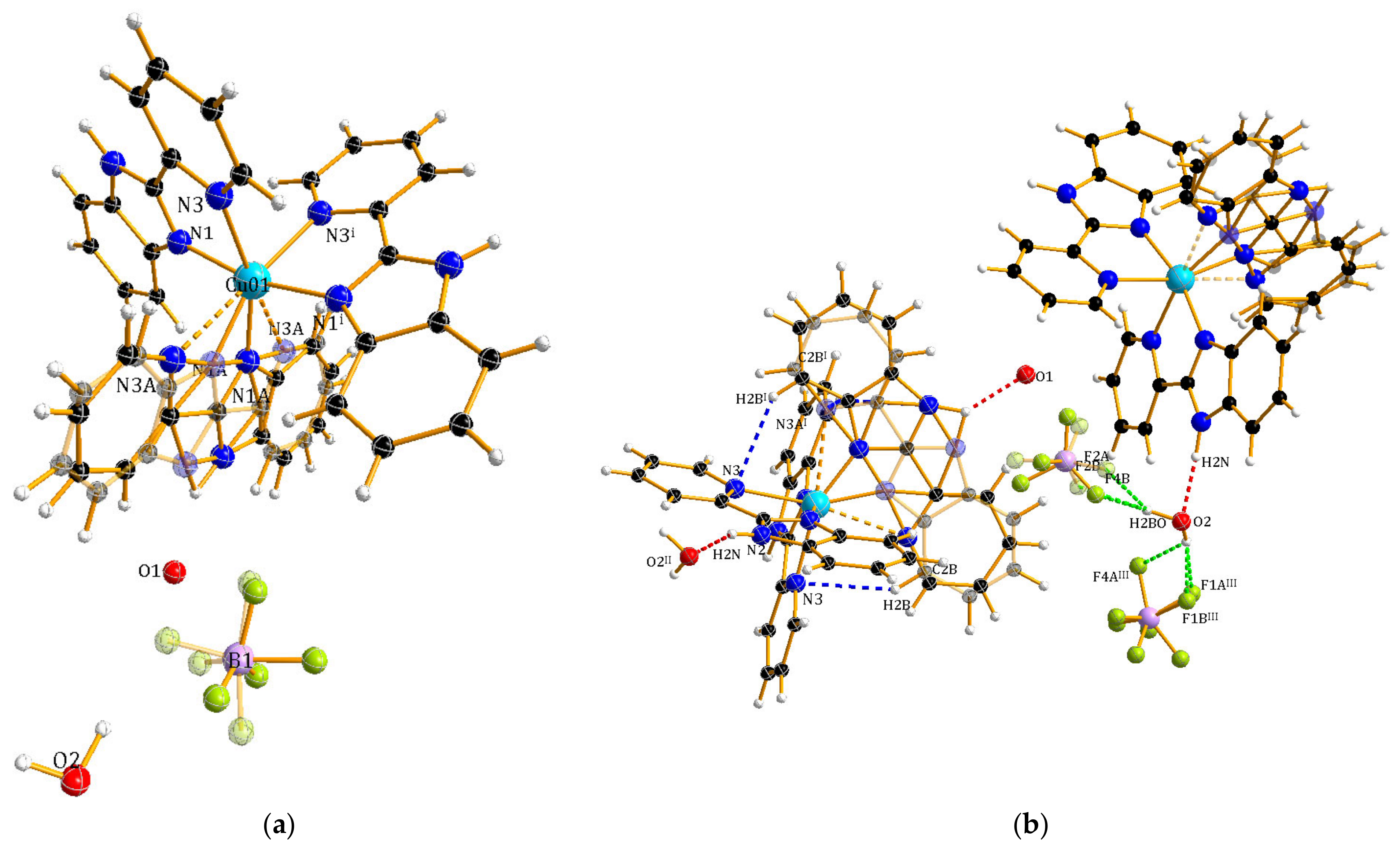
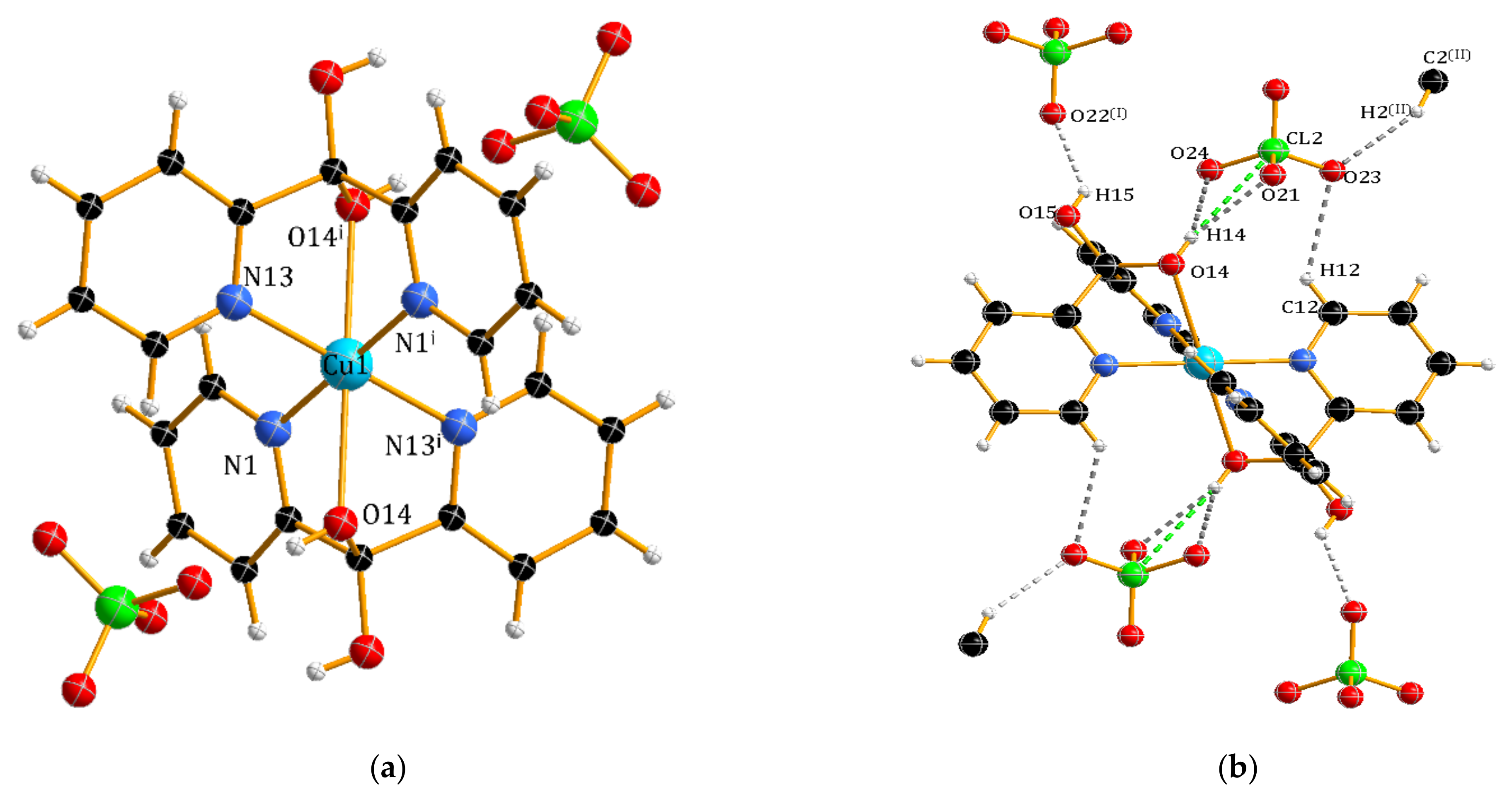
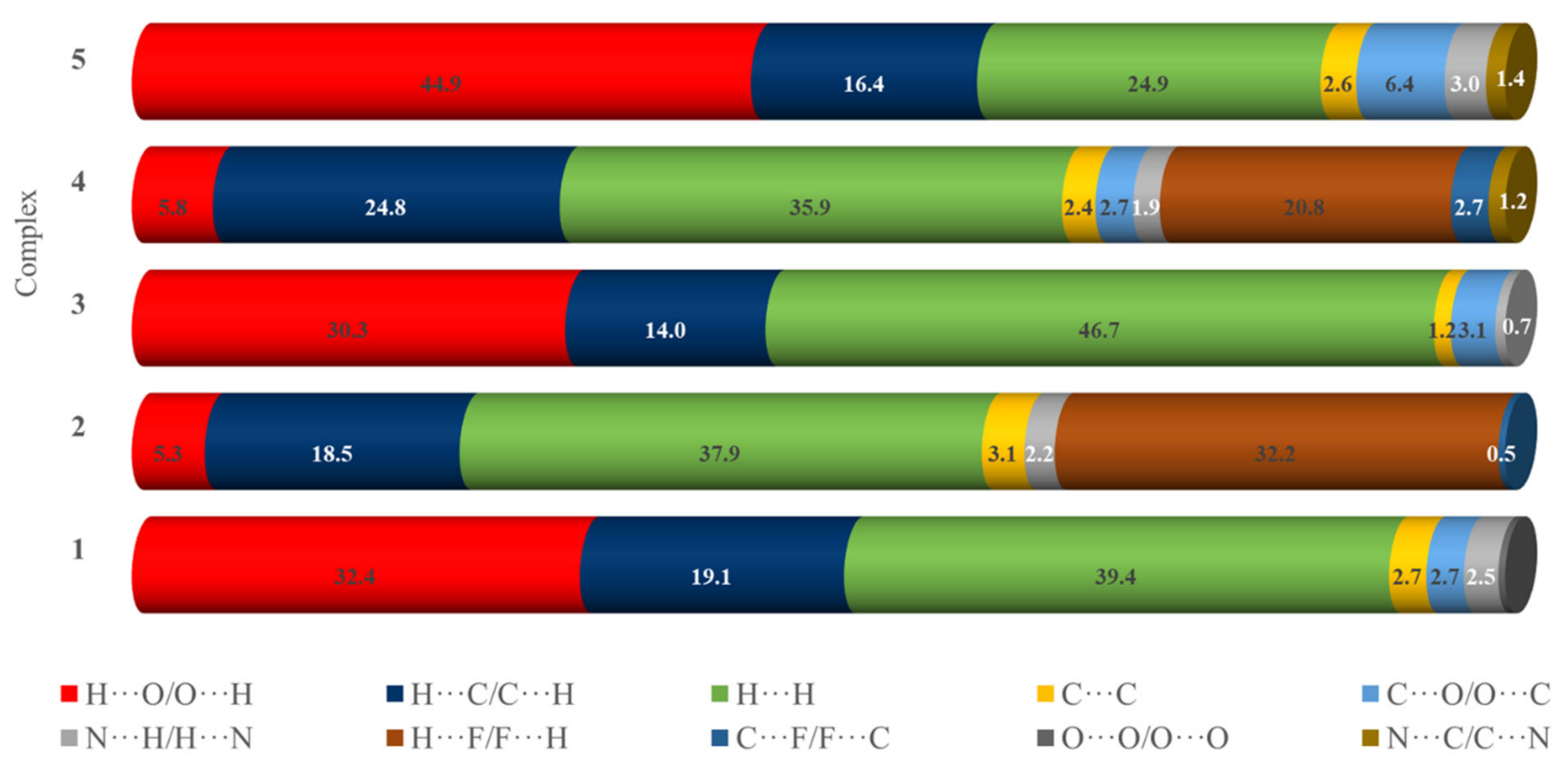
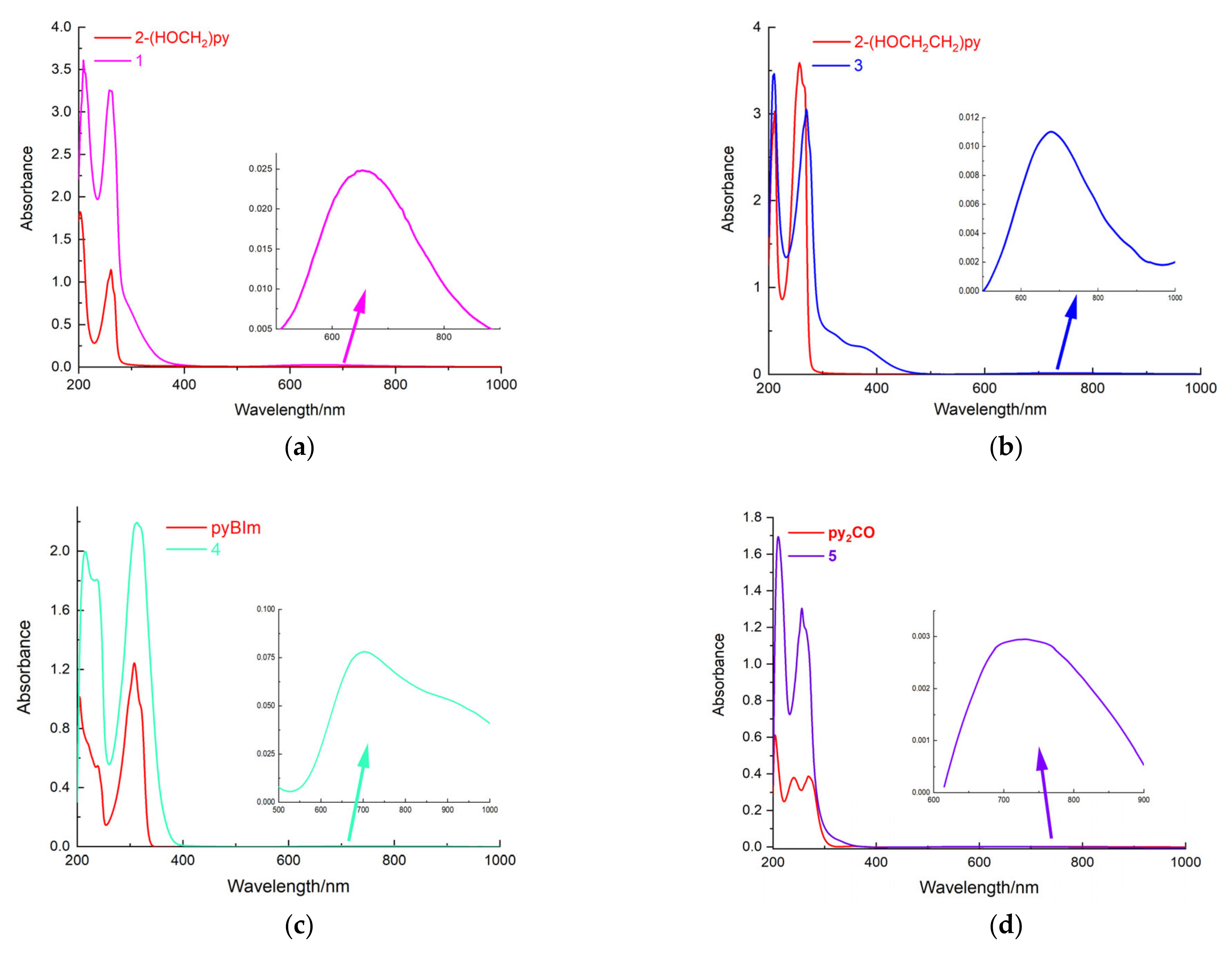
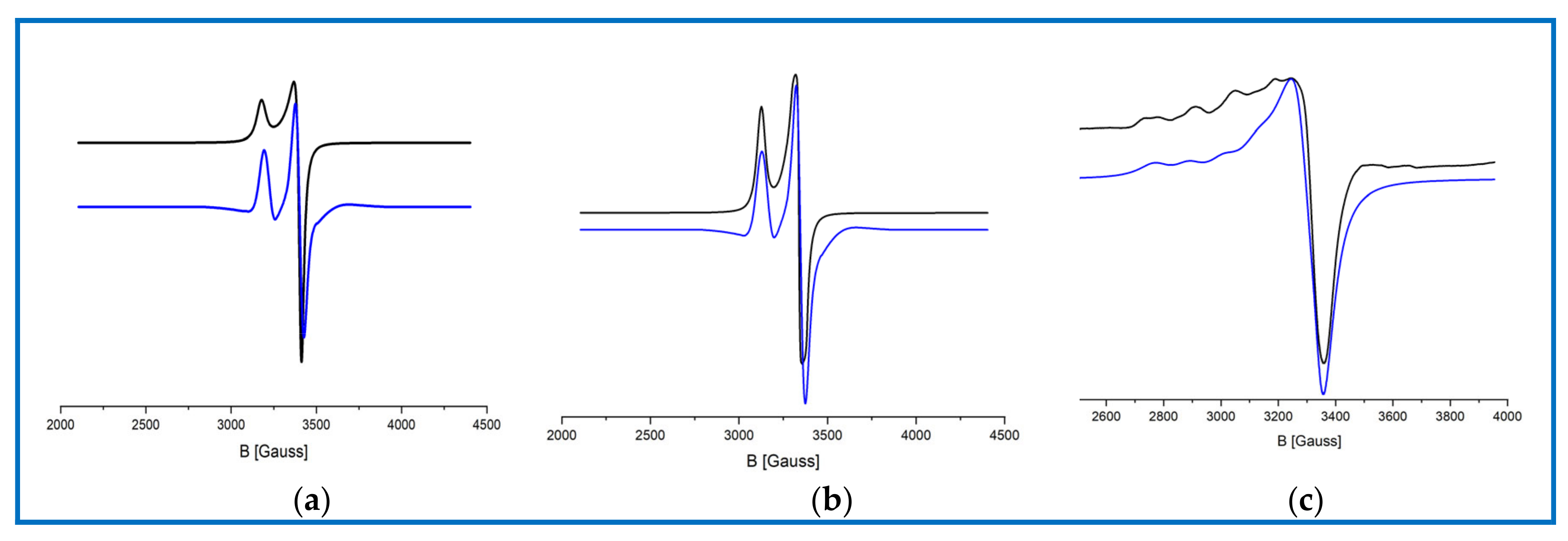
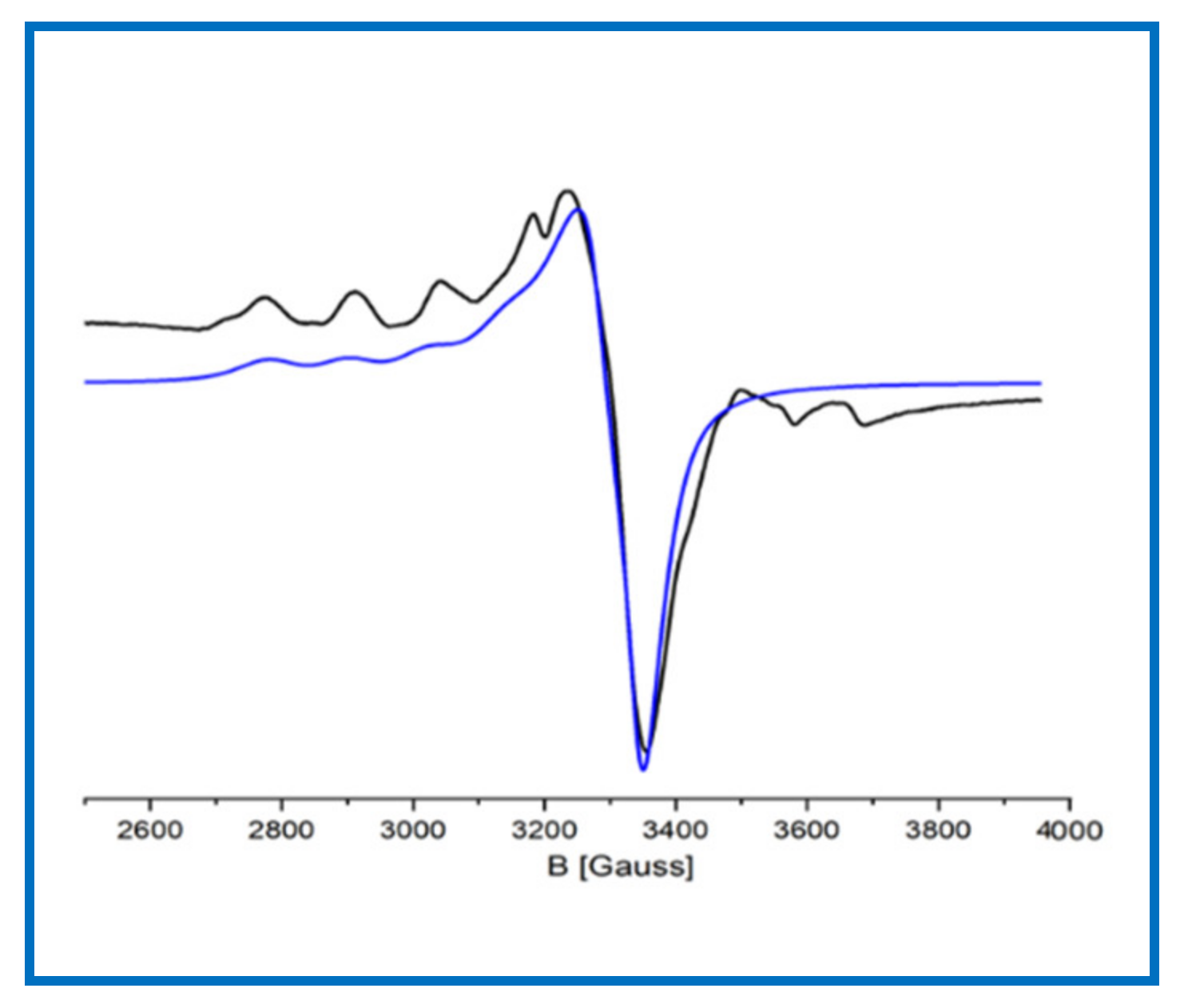
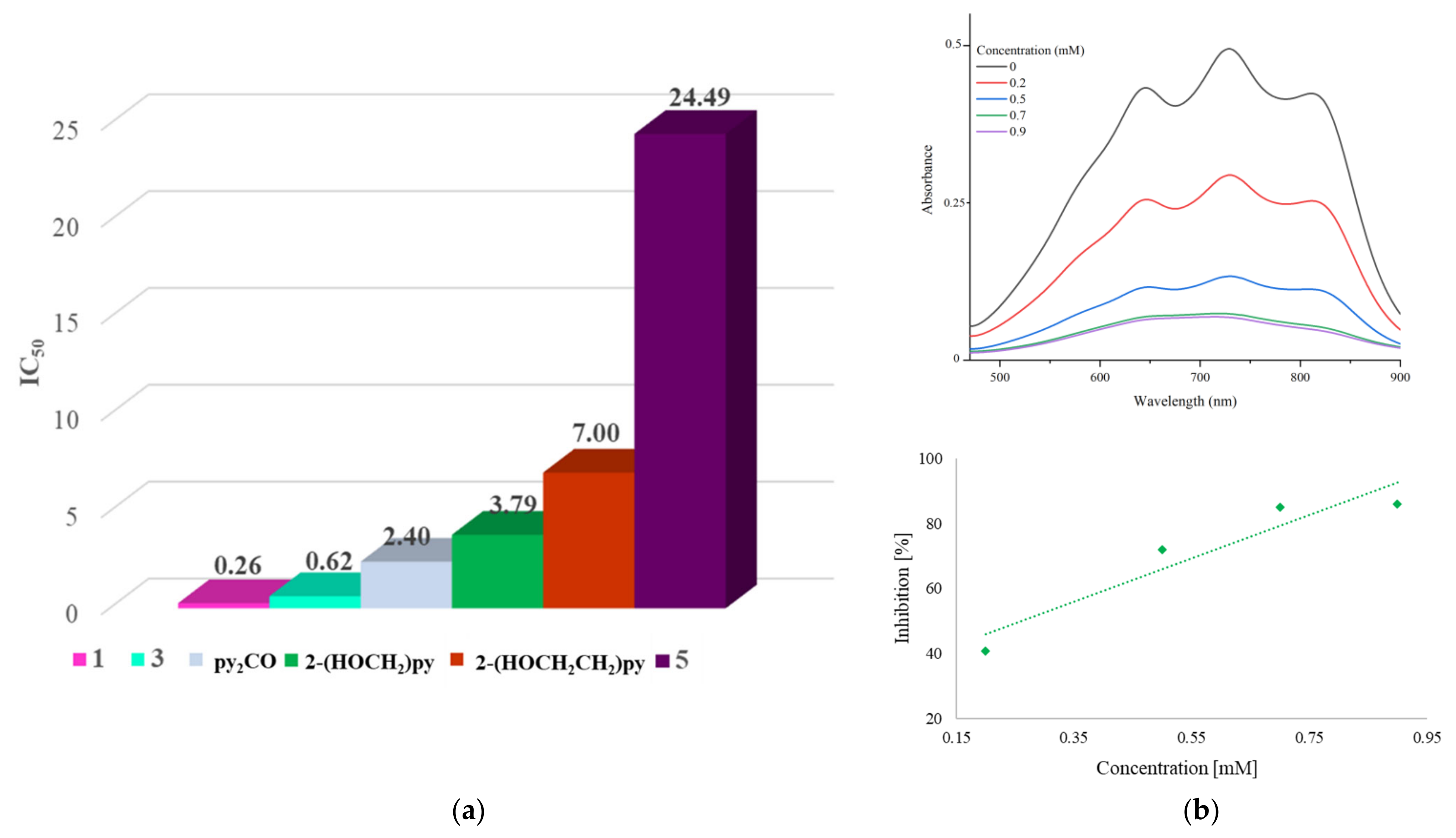

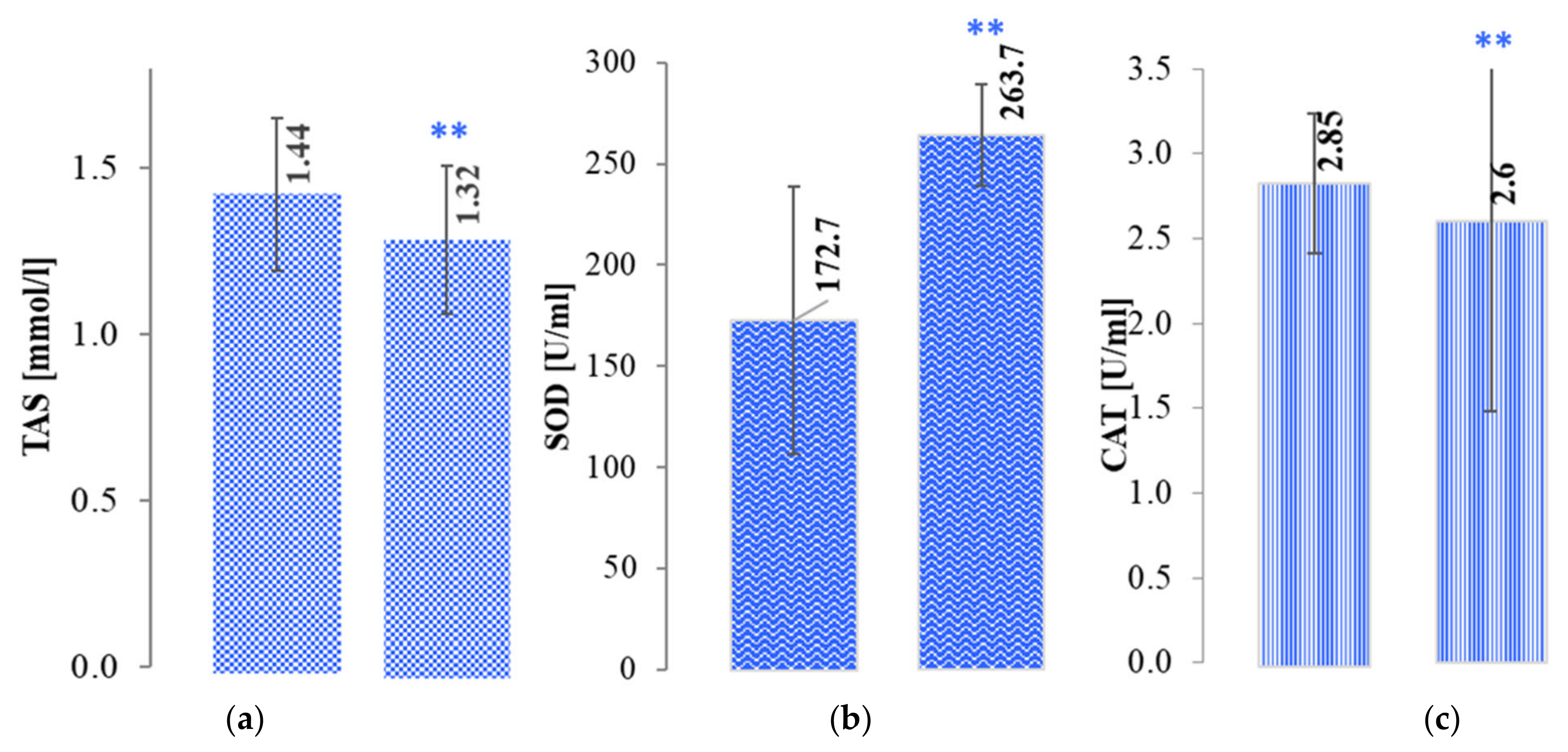
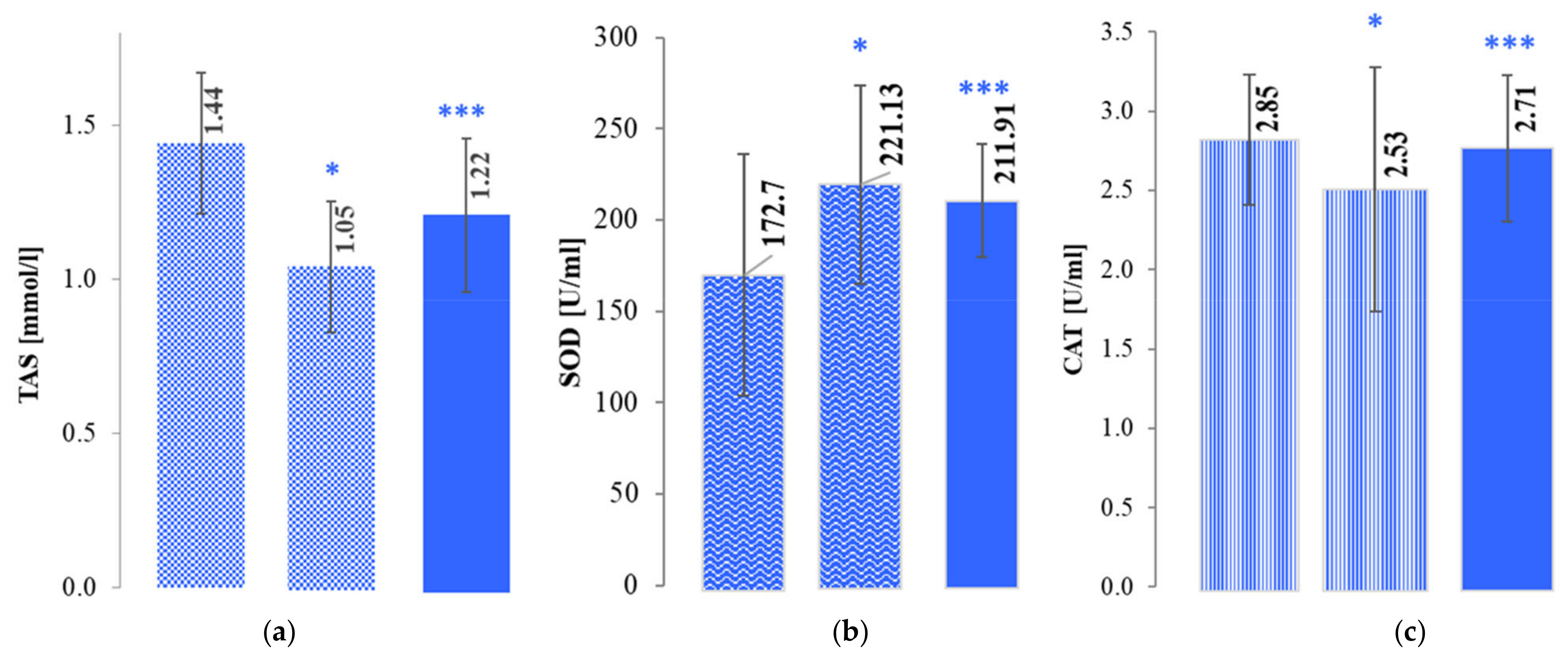
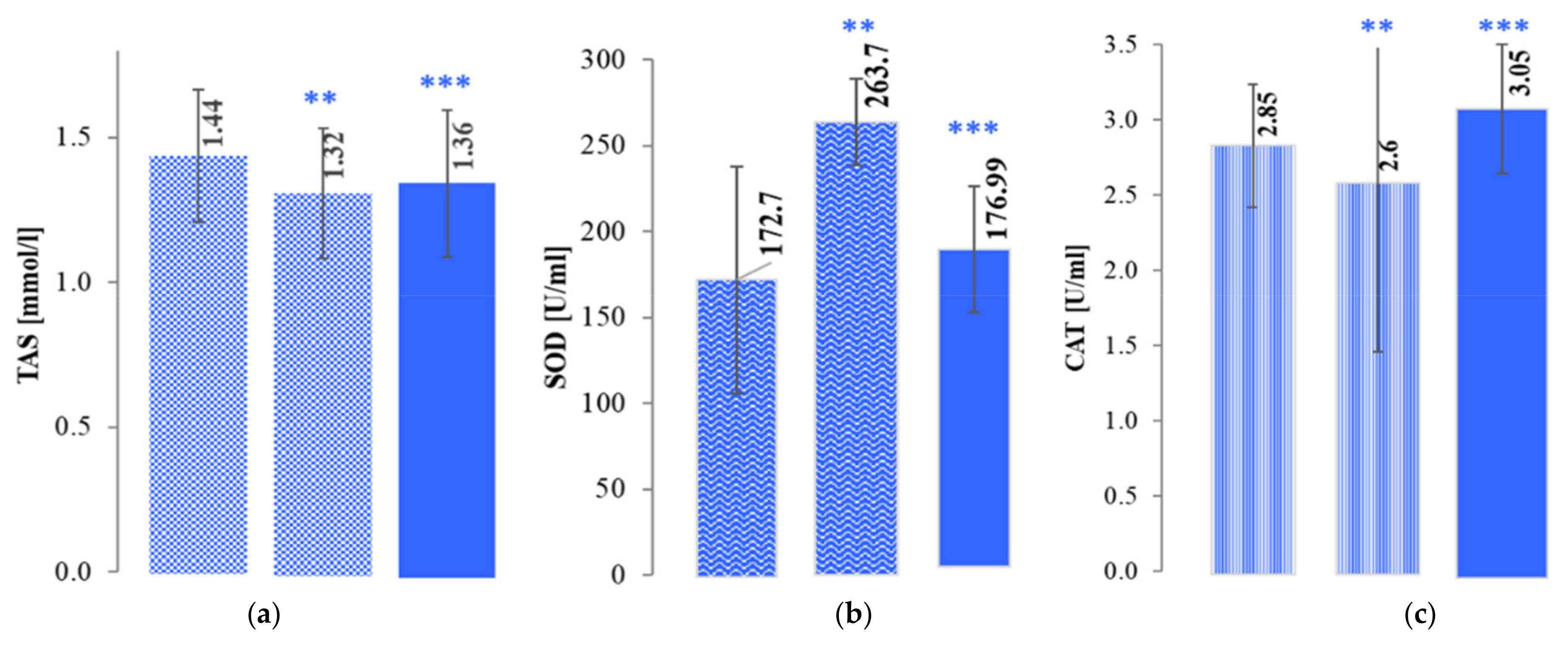
| 1 | 2 | 3 | |
| CCDC | 2079678 | 2079599 | 2079677 |
| Empirical formula | C18H21Cl2CuN3O11 | C12H18F6CuN2O4Si | C28H34Cl2Cu2N4O12 |
| Formula weight, g mol−1 | 589.82 | 459.91 | 816.57 |
| Temperature (K) | 120(2) | 293(2) | 120(2) |
| Wavelength (Å) | 0.71073 | 0.71073 | 0.71073 |
| Crystal system, space group | Monoclinic, C2/c | Monoclinic, P21/c | Orthorhombic, Pbcn |
| Unit cell dimensions | a = 19.2825(15) Å b = 12.2086(9) Å β = 116.227(6)° c = 20.4552(17) Å | a = 10.274(2) Å b = 10.125(2) Å β = 104.099(1) ° c = 16.733(3) Å | a = 14.4167(3) Å b = 8.8652(2) Å c = 25.3192(7) Å |
| Volume (Å3) | 4319.7(6) | 1688.20(6) | 3235.97(13) |
| Z, Calculated density (Mg/m3) | 4, 1.659 | 4, 1.810 | 4, 1.676 |
| F(000) | 2208 | 932 | 1672 |
| Crystal size (mm) | 0.32 × 0.28 × 0.23 | 0.20 × 0.10 × 0.10 | 0.23 × 0.20 × 0.18 |
| Theta range for data collection (°) | 2.561–25.499 | 2.825–27.472 | 2.697–25.499 |
| Index ranges | −21≤ h ≤ 23, −14 ≤ k ≤ 14, −24 ≤ l ≤ 24 | −12 ≤ h ≤ 13, −13 ≤ k ≤ 12, −21 ≤ l ≤ 21 | −16≤ h≤ 17, −9≤ k≤ 10, −30≤ l≤ 30 |
| Reflections collected/unique/observed [Rint] | 16,300/3808 [Rint = 0.0848] | 3861/3494 [Rint = 0.0394] | 21,812/3024 [Rint = 0.0715] |
| Max. and min. transmission | 0.7012 and 0.8339 | 0.760 and 0.869 | 0.7339 and 0.7937 |
| Data/restraints/parameters | 4019/0/316 | 3861/0/260 | 3024/0/248 |
| Goodness-of-fit on F2 | 1.233 | 1.020 | 1.222 |
| Final R indices [I > 2sigma(I)] | R1 = 0.056, wR2 = 0.1532 | R1 = 0.02412, wR2 = 0.0582 | R1 = 0.0824, wR2 = 0.1886 |
| R indices (all data) | R1 = 0.0485, wR2 = 0.1362 | R1 = 0.0281, wR2 = 0.0600 | R1 = 0.0871, wR2 = 0.1905 |
| Largest differences in peak and hole (e/Å−3) | 0.771 and −1.200 | 0.402 and −0.387 | 1.681 and −0.761 |
| 4 | 5 | ||
| CCDC | 2079602 | 2079600 | |
| Empirical formula | C36H31B2F8Cu2N9O3 | CuC22H20N4Cl2O12 | |
| Formula weight, g mol−1 | 874.89 | 666.86 | |
| Temperature (K) | 293(2) | 130(2) | |
| Wavelength (Å) | 0.71073 | 0.71073 | |
| Crystal system, space group | Orthorombic, Pccn | Monoclinic, P21/c | |
| Unit cell dimensions | a = 11.901(5) Å b = 14.380(5) Å c = 23.100(5) Å | a = 7.7600(3) Å b = 13.4650(4) Å β = 113.237(2)° c = 13.1130(3) Å | |
| Volume (Å3) | 3953(2) | 1259.01(7) | |
| Z, Calculated density (Mg/m3) | 4, 1.470 | 2, 1.759 | |
| F(000) | 1780 | 678 | |
| Crystal size (mm) | 0.45 × 0.21 × 0.14 | 0.30 × 0.20 × 0.15 | |
| Theta range for data collection (°) | 3.338–28.589 | 3.026–27.476 | |
| Index ranges | −15 ≤ h ≤ 15, −18 ≤ k ≤ 19, −30 ≤ l ≤ 30 | −10 ≤ h ≤ 8, −17 ≤ k ≤ 17, −16 ≤ l ≤ 16 | |
| Reflections collected/unique/observed [Rint] | 4874/3674 [Rint = 0.0978] | 2874/2348 [Rint = 0.0655] | |
| Max. and min. transmission | 0.682 and 0.857 | 0.723 and 0.846 | |
| Data/restraints/parameters | 4874/206/359 | 2873/0/196 | |
| Goodness-of-fit on F2 | 1.079 | 1.044 | |
| Final R indices [I > 2σ(I)] | R1 = 0.0894, wR2 = 0.1934 | R1 = 0.0493, wR2 = 0.0880 | |
| R indices (all data) | R1 = 0.0703, wR2 = 0.1786 | R1 = 0.0358, wR2 = 0.0815 | |
| Largest differences in peak and hole (e/Å−3) | 0.683 and −1.026 | 0.556 and −0.467 |
| Complex | Anions | Crystal System, Space Group | Bond Lenghts (Å) | Chromophore, Polyhedron | Ligand Coordination Mode | ||
|---|---|---|---|---|---|---|---|
| Cu-O | Cu-N | Cu-X | |||||
| [Cu2Br3(C11H9N2O2)] [30] | Br− | Triclinic, P-1 | 1.9513 (17) 1.9386 (17) | 1.981(2) 1.979(2) | 2.4592(4) 2.4613(4) 2.3507(4) 2.3862(4) 2.7923(4) | {CuNOBr2} | μ-κ4N,O:O,N′ |
| [Cu2Br4(C11H10N2O2)2]·2H2O [38] | Br− | Monoclinic, C2/c | - | 2.034 (5) 2.041 (5) | 2.4222(10) 2.4212(9) 3.1138(10) | {CuN2Br2} | κ2N,N′ |
| [Cu(dpydiol)2](Br)2·4H2O [28] | Br− | Monoclinic, C2/c | 2.464(3) | 2.011(4) | - | {CuN4O2} distorted octahedron | κ3N,O,N′ |
| [Cu(C11H10N2O2)2](BF4)2·2H2O [35] | BF4− | Monoclinic, P21/c | 2.4312(17) 2.4312(17) | 2.0099(19) 2.0146(19) 2.0147(19) | - | {CuN4O2] | κ3N,O,N′ |
| [Cu(pk·HO)2](NCS)2·H2O [29] | NCS− | Triclinic, P-1 | 2.389(1) | 2.008(1) 2.012(1) | - | {CuN4O2} distorted octahedron | κ3N,O,N′ |
| [Cu(C11H10N2O2)2](C1O4)2 [31] | ClO4− | Monoclinic P21/n | 2.454(2) | 2.009(2) 2.010(2) | - | {CuN4O2} distorted octahedron | κ3N,O,N′ |
| [Cu(py2C(OH)2)2](C1O4)2 [this work] | ClO4− | Monoclinic P21/c | 2.0089(19) 2.4429(1) | 2.0097(19) | - | {CuN4O2} distorted octahedron | κ3N,O,N′ |
| [Cu(C11H10N2O2)2](C2H3O2)2·4H2O [32] | CH3COO− | Monoclinic P21/n | 2.3990(14) | 1.9918(17) 2.0257(18) | - | {CuN4O2} distorted octahedron | κ3N,O,N′ |
| [Cu(C11H10N2O2)2](C2H3O2)2·4H2O [37] | CH3COO− | Monoclinic, C2/c | 2.394(1) | 2.021(2) 2.002(2) | - | {CuN4O2} | κ3N,O,N′ |
| [Cu[(2-Py)2CO(OH)]2(HO2CCH3)2 [34] | CH3COO− | Monoclinic, C2/c | 2.367(8) | 2.00(1) 2.03(1) | - | {CuN4O2} | κ3N,O,N′ |
| [Cu4[(2-Py)2CO(OH)]2(O2CCH3)6(H2O)2]·CH2Cl2 [34] | CH3COO− | Triclinic, P-1 | 1.964(4) 1.938(4) 2.258(4) | 1.991(6) | 2.277(5) 1.940(4) 1.974(4) 1.952(5) 1.946(4) | {CuN4O2} | μ-κ4N,O:O,N′ |
| [Cu(C11H10N2O2)2]C4H4O6 [33] | C4H4O62− | Triclinic, P-1 | 2.3920 (19) 2.3920 (19) | 2.003(2) 2.019(2) 2.019(2) | - | {CuN4O2} distorted octahedron | κ3N,O,N′ |
| [Cu(dpk·H2O)2]C6H5PO2OH2[C6H5PO(OH)2] [36] | C6H5PO2OH− | Monoclinic, C2/c | 2.418–2.425 | 2.007 2.012 2.008 2.020 | - | {CuN4O2} | κ3N,O,N′ |
| Compound | Assignments | |||||||||
|---|---|---|---|---|---|---|---|---|---|---|
| ν(OH)H2O | ν(OH)ligand | ν(NH) | ν(C-O) | ν(C=O) | ν(C=C) | ν(C=N) | νClO4− | νSiF62− | νBF4− | |
| 2-(HOCH2)py | - | 3245 | - | 1054 | - | 1594, 1574 | 1479, 1435 | - | - | - |
| 1 | - | 3425 (Δ = 180) | - | 1068 (Δ = 14) | - | 1610, 1576 | 1487, 1444 (Δ = 9, 9) | 1091 | - | - |
| 2 |  3500–3000 (3381) 3500–3000 (3381) | - | 1068 (Δ = 14) | - | 1613, 1573 | 1495, 1448 (Δ = 16, 13) | - | 764, 725 | - | |
| 2-(HOCH2CH2)py | - | 3245 | - | 1057 | - | 1593, 1568 | 1476, 1435 | - | - | - |
| 3 | - | 3450 (Δ = 205) | - | 1066 (Δ = 9) | - | 1610, 1570 | 1487, 1437 (Δ = 11, 2) | 1086 | - | - |
| pyBIm | - | - | 3057 | - | - | 1593, 1568 | 1441, 1400 | - | - | - |
| 4 | 3590 | - | 3590 | - | - | 1598, 1567 | 1450, 1422 (Δ = 9, 22) | - | - | 1052 |
| py2CO | - | - | - | - | 1683 | 1581 | 1429 | - | - | - |
| 5 | - | 3485 | - | 1067 | - | 1606 | 1447 (Δ = 18) | 1090 | - | - |
| Compound (Solvent) | Chromophore | Equatorial Donor Atoms | Colour | d-d (ε (dm3 mol−1 cm−1)) | LMCT | n→π* | π→π* |
|---|---|---|---|---|---|---|---|
| 2-(HOCH2)py | - | 261 | 203 | ||||
| 1 (EtOH) | {CuN3O3} | N3O | light blue | 654 (51) | 261 | 209 | |
| 2-(HOCH2CH2)py | - | 266, 257 | 211 | ||||
| 3 (MeOH) | {CuN2O3} | N2O2 | blue | 662 (105) | 346, 303 | 261 | 209 |
| pyBIm | - | 320, 308 | 238, 204 | ||||
| 4 (MeOH) | {CuN6} | N4 | green | 702 (29) | 320, 313 | 236, 215 | |
| py2CO | - | 268, 240 | 204 | ||||
| 5 (MeOH) | {CuN4O2} | N4 | violet | 560 (52) | 264, 255 | 209 |
| Parameter | Control Group | Oncology Patients after Treatment | |
|---|---|---|---|
| Chemotherapy | Radiochemotherapy | ||
| TAS (mmol/L) | 1.44 ± 0.33 (1.25–1.63) | 1.05 ± 0.16 (0.78–1.32) | 1.32 ± 0.26 (1.16–1.63) |
| SOD (U/mL) | 172.70 ± 66.12 (133.59–236.93) | 221.13 ± 54.51 (172.59–251.80) | 263.70 ± 126.87 (168.22–384.36) |
| CAT (U/mL) | 2.85 ± 0.41 (2.30–3.39) | 2.53 ± 0.77 (1.42–3.25) | 2.60 ± 1.12 (1.03–4.65) |
| GPx (U/mL) | 0.19 ± 0.11 (0.11–0.27) | 0.15 ± 0.07 (0.08–0.20) | 0.11 ± 0.05 (0.07–0.13) |
Publisher’s Note: MDPI stays neutral with regard to jurisdictional claims in published maps and institutional affiliations. |
© 2021 by the authors. Licensee MDPI, Basel, Switzerland. This article is an open access article distributed under the terms and conditions of the Creative Commons Attribution (CC BY) license (https://creativecommons.org/licenses/by/4.0/).
Share and Cite
Masternak, J.; Zienkiewicz-Machnik, M.; Łakomska, I.; Hodorowicz, M.; Kazimierczuk, K.; Nosek, M.; Majkowska-Młynarczyk, A.; Wietrzyk, J.; Barszcz, B. Synthesis and Structure of Novel Copper(II) Complexes with N,O- or N,N-Donors as Radical Scavengers and a Functional Model of the Active Sites in Metalloenzymes. Int. J. Mol. Sci. 2021, 22, 7286. https://doi.org/10.3390/ijms22147286
Masternak J, Zienkiewicz-Machnik M, Łakomska I, Hodorowicz M, Kazimierczuk K, Nosek M, Majkowska-Młynarczyk A, Wietrzyk J, Barszcz B. Synthesis and Structure of Novel Copper(II) Complexes with N,O- or N,N-Donors as Radical Scavengers and a Functional Model of the Active Sites in Metalloenzymes. International Journal of Molecular Sciences. 2021; 22(14):7286. https://doi.org/10.3390/ijms22147286
Chicago/Turabian StyleMasternak, Joanna, Małgorzata Zienkiewicz-Machnik, Iwona Łakomska, Maciej Hodorowicz, Katarzyna Kazimierczuk, Milena Nosek, Amelia Majkowska-Młynarczyk, Joanna Wietrzyk, and Barbara Barszcz. 2021. "Synthesis and Structure of Novel Copper(II) Complexes with N,O- or N,N-Donors as Radical Scavengers and a Functional Model of the Active Sites in Metalloenzymes" International Journal of Molecular Sciences 22, no. 14: 7286. https://doi.org/10.3390/ijms22147286
APA StyleMasternak, J., Zienkiewicz-Machnik, M., Łakomska, I., Hodorowicz, M., Kazimierczuk, K., Nosek, M., Majkowska-Młynarczyk, A., Wietrzyk, J., & Barszcz, B. (2021). Synthesis and Structure of Novel Copper(II) Complexes with N,O- or N,N-Donors as Radical Scavengers and a Functional Model of the Active Sites in Metalloenzymes. International Journal of Molecular Sciences, 22(14), 7286. https://doi.org/10.3390/ijms22147286






